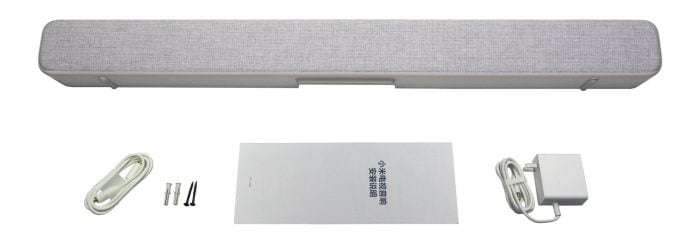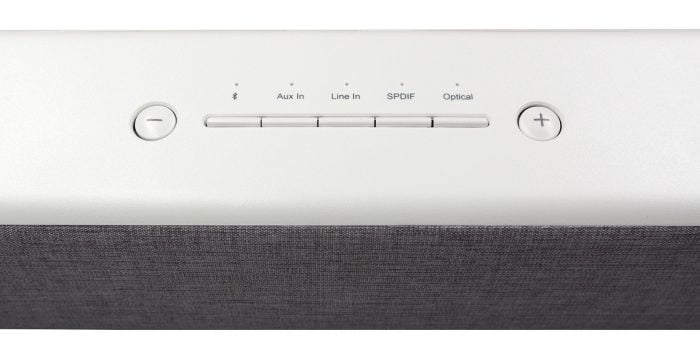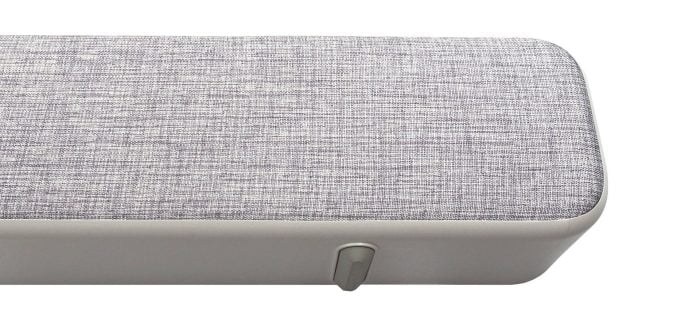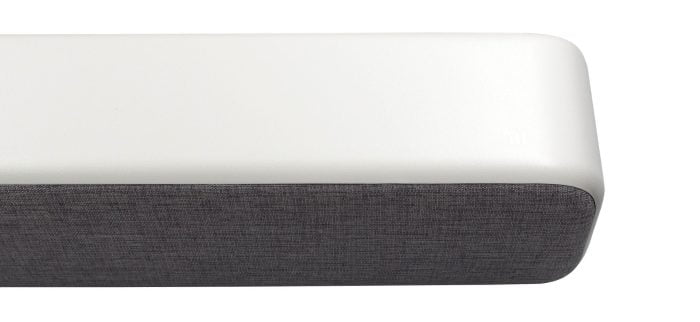Foreword: Xiaomi Soundbar
Current generations of flat screen televisions are getting slimmer, which is why there is hardly any space for good sounding sound systems in the flat TV housings. In order to enhance the sound of the home cinema experience, a so-called soundbar is available, which is placed underneath the TV set to save space.
Design, workmanship and delivery
The elongated Xiaomi soundbar is comparatively slim and optically goes well with the design of modern flat screen televisions. The plain white housing is made entirely of plastic. A total of two tweeters, two subwoofers and four passive membranes are hidden behind a checkered fabric front over a length of 88 cm. There is no external subwoofer!

The soundbar is operated using seven buttons located in the middle of the top of the housing. The volume control buttons are located on the far left and right. Again in the middle of it there is a Bluetooth button, an Aux-In button, a Line-In button, a SPDIF button and an Optical button. All control buttons are identified by symbols and each has a status LED. Operation by remote control is unfortunately not provided!

The connection options are in the middle of the back of the soundbar. These amount to a DC power input, a Toslink socket, an SPDIF socket, a line-in (cinch) and an AUX-in. The rocker switch for switching on the soundbar is located next to the connections. There is no HDMI input / output or a USB connection option!

Rubber pads on the underside ensure that the 1.92 kg heavy Xiaomi soundbar is non-slip and cushioned. Wall mounting is possible. A wall bracket for hanging the soundbar into a screw mount is located on the back of the housing.
The processing quality corresponds to the price and is not objectionable. The scope of delivery includes the soundbar, a power supply unit with NEMA-1 connector, an SPDIF cable, two screws and two wall plugs, as well as a Chinese instruction manual.

OPERATION
In addition to wired use, the Xiaomi Soundbar can also be connected to a playback device via Bluetooth. The Bluetooth standard used is version 4.2. The loudspeaker identifies itself as the “Mi TV Soundbar” via the Bluetooth settings of the mobile device. The soundbar does not support the almost lossless aptX audio codec!

In the absence of a remote control, the source can only be selected using the loudspeaker control buttons. If you are not connected via Bluetooth and control the volume via the playback device, the volume can only be controlled directly via the soundbar. Volume control via the television is not possible!

The lack of remote control proved to be extremely impractical in the test. Here at least an IR / App control option via the Mi Remote App would have been desirable.
sound quality
Two 36 mm tweeters, two 65 mm subwoofers and four 70 x 55 mm passive membranes are responsible for the sound generation. The output power of the Xiaomi Soundbar is a comparatively low 28 watts (2x 14 watts). The manufacturer specifies the nominal impedance as 6 ohms, the frequency response is between 50 Hz and 25.000 Hz.

The sound of the Xiaomi soundbar is acceptable. Usually flat-sounding, internal speaker systems of conventional TV sets, the soundbar is definitely a (sonic) step ahead. However, the Xiaomi speaker system does not come close to an extensive multi-channel speaker system or a soundbar with an external subwoofer.
The sound can be described as full and warm. The mid and low frequencies are particularly pronounced, which means that film effects come across as powerful. Because of the rather round sound, the highs tend to be cautious. As a result, the soundbar lacks clarity, which is why it is less suitable for music playback. Voices sometimes sound dull.

The overall sound is homogeneous and coherent. A certain depth of space is recognizable, although not too pronounced. The depth of the room is increasingly lost in rooms that are too large and if the seat spacing is too great. The maximum volume is convincing. An unpleasant distortion at high volume cannot be detected. There are no sound features or enhancers such as a virtual 3D surround sound, an equalizer or a night mode. Multichannel sound systems are also not supported by Dolby or DTS.